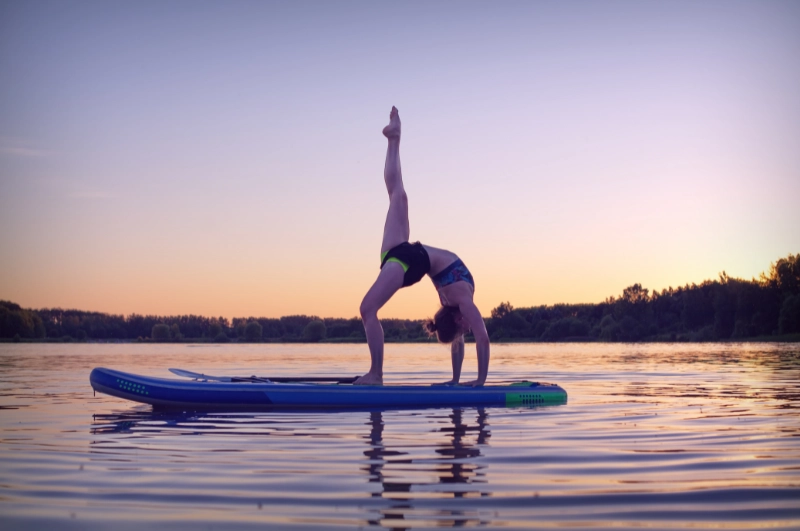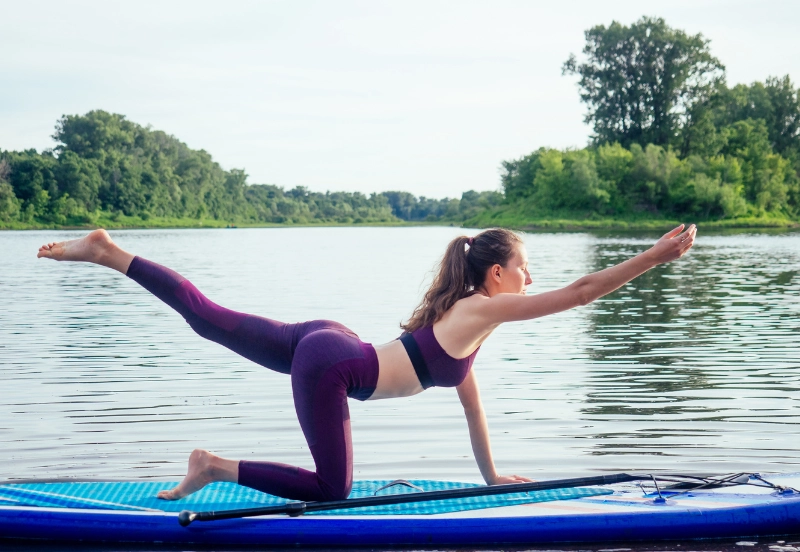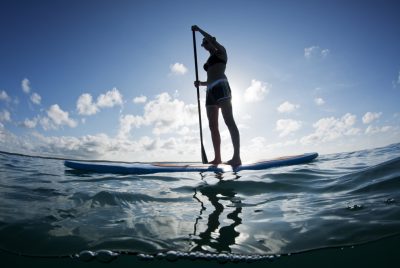SUP Yoga: Finding Balance and Serenity on the Water
We may earn a commission for purchases made using our links. Please see our disclosure to learn more.
Welcome aboard! If you’ve ever wondered about SUP Yoga, let me assure you, you’re in for a treat. Let’s dive into it, shall we?
What is SUP Yoga?
SUP stands for Stand-Up Paddleboarding, and yes, you guessed it right, SUP Yoga is the delightful union of yoga and stand-up paddle boarding. It involves practicing traditional yoga poses on a paddleboard in the middle of a calm water body. Sounds fun, right?
History and Origin
As a practice, SUP Yoga is quite young. It emerged around the early 2000s when yoga enthusiasts started taking their mats onto paddleboards, seeking a greater challenge and connection to nature.
Why SUP Yoga?
Practicing yoga on an unstable surface like a paddleboard requires greater focus, balance, and core strength. This not only intensifies your workout, but it also adds an extra layer of peace and serenity as you connect with the natural world around you.
Connection with Nature: Imagine doing your Sun Salutations under the real sun, feeling the wind in your hair, and hearing the water ripple beneath you. SUP Yoga allows you to connect with nature in a profound, intimate way.
Improving Balance and Strength: Yoga on a paddleboard demands more from your muscles than yoga on solid ground. It engages your core, enhances your balance, and boosts overall strength.
Stress Relief and Mindfulness: There’s nothing quite like the tranquil ambiance of water for achieving mindfulness. SUP Yoga can be a magical stress-buster!
Getting Started with SUP Yoga
If you’ve ever wanted to combine the calm, tranquil poses of yoga with the thrill and excitement of surfing, then welcome to the wonderful world of SUP Yoga. But how does one get started, you ask? Grab your paddle, my friend, because we’re about to dive in!
Choosing the Right Equipment
First thing’s first, you’ll need a good paddle board. A wide, stable board is perfect for beginners. Look for a board specifically designed for Yoga like the Sea God Infinite Mantra, which often have a soft top and places to secure your paddle while you practice.
Starting Out
Now, you might think that you need to be a yoga master or an experienced surfer to get started, but that couldn’t be further from the truth. Yes, having some yoga or paddle boarding experience helps, but it’s certainly not a prerequisite. Start with simple poses like Child’s Pose, Downward Dog, or Mountain Pose. Be patient with yourself and remember, the joy is in the journey!
Finding a Suitable Location
Look for calm, shallow waters to start with. Lakes, ponds, or calm sea areas are excellent choices.
Taking a Class
One of the best ways to get started is to take a class. An experienced instructor can guide you on everything from paddling techniques to proper yoga poses.
Practice Makes Perfect
Remember, practice is crucial. SUP Yoga is a unique challenge, and it will take time to get comfortable balancing on the board. But stick with it – the benefits are well worth the effort.
Finding Your Community
Lastly, join a community of other SUP Yoga enthusiasts. Not only can they provide support and advice, but sharing experiences with others can make your yoga journey all the more enriching.
Mastering SUP Yoga
Embarking on the SUP Yoga journey can initially seem intimidating, yet with patience and commitment, it’s an art that can certainly be refined. This practice goes beyond simply achieving yoga poses on a paddle board. The essence lies in intertwining yoga’s mindfulness with the balance and resilience demanded to remain steady on a shifting platform. The goal is to sync with the ebb and flow of the water, letting it direct your yoga routine.
Finding Your Sea Legs
The first step to mastering SUP Yoga is to get comfortable on your board. Spend time just paddling around, feeling how the board moves with the water. Get to know how your weight distribution affects the board’s balance. Practice transitioning from kneeling to standing. These foundational skills are key before moving into more advanced yoga poses.
Improving Your Balance
A lot of the challenges come down to balance. Regular yoga poses become a whole new challenge when the ground beneath you is constantly shifting. Incorporate balance exercises into your everyday routine. This can be as simple as practicing standing on one foot or trying a few yoga poses on a balance board. The more you can improve your balance on dry land, the better you’ll fare on the water. With consistent practice, you’ll gain confidence to try more complex poses. You might even enjoy the occasional splash when you fall!
Expanding Your Yoga Practice
While the surfing aspect of SUP Yoga is unique, the yoga aspect is familiar. Regularly practicing yoga on solid ground will undoubtedly help your SUP Yoga practice. Aim to expand your repertoire of poses and work on your flexibility and control. The more comfortable you are with a pose on land, the easier it’ll be to adapt it to your board.
Listening to Your Body
Mastering SUP Yoga isn’t about being the most flexible or the strongest; it’s about understanding your body and its limits. If a pose feels uncomfortable or causes strain, don’t push it. It’s better to execute a simpler pose perfectly than to risk injury with a more complicated pose. Remember, yoga is a personal journey, not a competition.
Exploring Advanced Techniques
Once you’re comfortable with basic poses and have improved your balance, start exploring more challenging poses. From headstands to more complex asanas like the warrior sequence, advancing your practice will keep it fresh and exciting. Just remember to always prioritize safety and never attempt advanced poses without proper guidance or supervision.
Consistent Practice
Above all, consistency is key in mastering a new skill. Make it a regular part of your routine and try to get on your board as often as possible. Like any skill, the more you practice, the better you’ll get. And who knows? One day you might just find yourself moving through your yoga flow on your paddleboard as naturally as breathing.
This is a journey that requires patience, dedication, and self-awareness. But with each practice, you’ll find yourself more in tune with your body and the water, moving smoothly from one pose to another. Before you know it, you’ll have mastered the art, finding a unique sense of tranquility and balance on your board.
Incorporating Meditation
Don’t forget, yoga isn’t just about the poses. The serene setting of being on the water provides a perfect opportunity for mindful meditation.
Safety Considerations for SUP Yoga
Safety is integral to SUP Yoga and there are several precautions you can take to ensure you stay safe while enjoying your tranquil, waterborne asanas.
Choosing the Right Environment
Always perform SUP Yoga in calm waters, preferably with a slow current. It’s a good idea to start in a sheltered area, such as a quiet lake or bay, before trying more challenging conditions.
Getting the Right Equipment
Having the right equipment is key to your safety on the water. This includes a sturdy and stable yoga-specific paddleboard, a leash to keep you attached to your board, and a Personal Flotation Device (PFD) in case you end up in the water.
Staying Aware of Weather Conditions
Keep an eye on the weather. It’s not safe to practice SUP Yoga during a storm, heavy winds, or when the water is choppy. The ideal conditions are a clear sky and calm water.
Starting Slow
If you’re new to SUP Yoga, start with simple poses that you’re comfortable with and gradually move to more complex ones as your confidence grows. Don’t push yourself to try difficult poses until you’re ready.
Taking a Buddy Along
If possible, bring a friend along when you’re doing SUP Yoga, especially when you’re starting out. Having a buddy nearby is not only more fun but also safer.
Keeping Hydrated and Protected from the Sun
Remember, you’re out in the sun and on the water. Keep a water bottle handy on your SUP and don’t forget to apply a water-resistant sunscreen to protect your skin.
Knowing How to Swim
This one might seem obvious, but it’s crucial. Make sure you’re a competent swimmer before you attempt SUP Yoga. If you’re not confident in your swimming abilities, consider wearing a life jacket.
Practicing with a Group or Instructor
Especially when starting out, consider practicing with a group or hiring an instructor to guide you safely.
Benefits of SUP Yoga
Beyond fun and novelty, SUP Yoga has some serious benefits:
Physical Benefits
SUP Yoga is a full-body workout that improves balance, strength, and flexibility. You’ll engage muscles you never knew you had!
Mental Benefits
The combination of nature, exercise, and mindful meditation does wonders for your mental health. It reduces stress, boosts mood, and improves concentration.
Overcoming Challenges
SUP Yoga might seem daunting, but don’t worry, every challenge can be overcome:
Dealing with Fear of Falling
Falling is part of the process. Embrace it, laugh it off, and climb back on!
Maintaining Balance in Windy Conditions
A gentle breeze can make balancing tricky, but with practice, you’ll learn to adjust your poses and center of gravity accordingly.
Increasing Flexibility for SUP Yoga
Some yoga poses require more flexibility. Regular yoga stretches on and off the board can help.
Conclusion
Standup Paddleboarding Yoga is more than just a trend. It’s a unique, exhilarating way to enhance your yoga practice. Whether you’re a seasoned yogi or a curious beginner, SUP Yoga has something to offer. So why not step out of the studio, grab a paddleboard, and give it a try?
FAQs
1. Is SUP Yoga suitable for beginners?
Yes, beginners can certainly try SUP Yoga! Start with simple poses and gradually try more complex ones as you gain confidence.
2. Do I need to know how to swim for SUP Yoga?
Knowing how to swim provides an added safety, but always remember to wear your life jacket, irrespective of your swimming ability.
3. What should I wear for SUP Yoga?
Opt for breathable, quick-drying athletic wear. Don’t forget sunscreen and a hat for protection from the sun.
4. Can I practice SUP Yoga in winter?
Yes, you can, if the water bodies near you are safe and unfrozen. You might need to add a wet suit to your gear list, though!
5. How often should I practice SUP Yoga?
Like any exercise, consistency is key in SUP Yoga. A few times a week would be great for most people.





